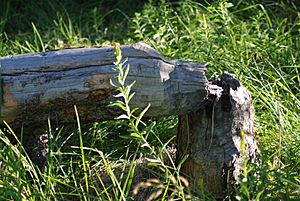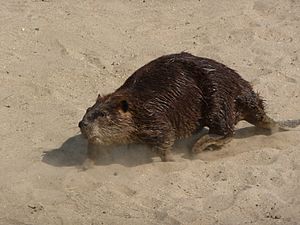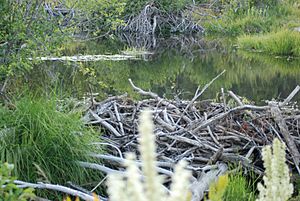Beaver in the Sierra Nevada facts for kids
The North American beaver (Castor canadensis) once lived all across the Sierra Nevada mountains in California. Before Europeans arrived in the Americas, beavers were found from the cold arctic lands all the way to the deserts of northern Mexico. The California Golden beaver (Castor canadensis subauratus) was common in the Sacramento River and San Joaquin River areas. This included rivers flowing from the Sierra Nevada. Recent discoveries show that beavers were native to the High Sierra until they disappeared in the 1800s.
For a long time, people thought beavers were not native to the Sierra Nevada. They were even seen as a problem. Beavers and their dams are still sometimes removed by wildlife managers in the Sierra Nevada. However, there is now strong proof that beavers belong there. Their dams also help the environment. They create wetlands that are good for fish and many other animals in the mountains.
Contents
Beavers: A Look Back in Time
In 1916, a writer named Harold Bryant said that mountain beavers in California were gone. He noted only a few hundred were left along the Sacramento, Colorado, and San Joaquin Rivers. Earlier, in 1906, Frank Stephens wrote that beavers used to live from Alaska down to central California. This included the Sierra Nevada and Cascade Mountains. He also mentioned that in many parts of California, the only sign of beavers was the stumps of trees they had cut.
Some people thought beavers were trapped out of the Sierra early in the 1800s. Other naturalists in the early 1900s wondered if the California Golden beaver lived above 1,000 feet (300 m) in the Sierra. But new physical evidence has shown that beavers were native to the Sierra. Scientists used radiocarbon dating on old beaver dam wood. This wood was found in Red Clover Creek in the Feather River area. This discovery, along with old stories from people who saw beavers, proves they lived across the Sierra Nevada. This includes the eastern side of the mountains.
Bringing Beavers Back Home
In the 1940s, the California Department of Fish and Game (CDFG) brought California Golden beavers back to the Sierra. These beavers came from lower elevation areas like Snelling, California and Waterford, California. They were released at places like Mather Station (at 4,522 ft or 1,378 m) near Yosemite National Park. They were also released at Fish Camp (at 5,062 ft or 1,543 m).
These beavers, originally from the Central Valley, have been building dams and raising young successfully. They have lived for over 70 years in and near Yosemite at elevations higher than 5,000 feet (1,500 m). This shows that beavers from lower areas can easily adapt to the high Sierra.
Beavers were also brought to the Lake Tahoe area between 1934 and 1949. This was done by the CDFG and the U. S. Forest Service. Their goal was to help streams and restore wetlands. These beavers came from the Snake River in Idaho. By 1987, beaver groups on the upper and lower Truckee River had grown. There were about 0.72 beaver colonies (or 3.5 beavers) per kilometer of river.
How Beavers Help Nature
Beavers are often called "ecosystem engineers." This means they change their environment in ways that help many other plants and animals. Their dams create ponds and wetlands. These areas provide homes and food for many different species.
Beavers and Trees
Beavers use trees like Quaking aspen (Populus tremuloides) and Black cottonwood (Populus trichocarpa) for food and building materials. In 1987, a study showed that beavers had caused some local loss of these trees along parts of the lower Truckee River. However, Willow (Salix spp.) trees remained healthy even with heavy use by beavers.
Some worried that aspen and cottonwood trees might disappear without beaver control. But these trees have survived. A recent study of ten Tahoe streams used special aerial cameras. It found that leafy plants, thick grasses, and thin grasses grew more around beaver dams. This shows that beaver dams help these plants grow. These findings match other studies. For example, in Oregon, beaver dams made the green areas along stream banks much wider. This happened because the dams watered dry land next to the stream.
Beavers and Fish
For a long time, people thought beavers were bad for fish. They believed beaver dams blocked fish like trout and salmon from swimming upstream to lay eggs. But studies have shown that trout and salmon can easily move over and around beaver dams.
In fact, beaver dams can actually help fish. Research on brook, rainbow, and brown trout in Sagehen Creek (which flows into the Little Truckee River) found that beaver dams increased the number of fish, their size, or both. The ponds created by dams offer deeper, cooler water and more places for fish to hide and find food.
Managing Beavers Today
Beavers have been seen in many places around Lake Tahoe. This includes the upper and lower Truckee River, Ward Creek, Cold Creek, Taylor Creek, Meeks Creek, Blackwood Creek, and King's Beach. This means the beavers brought back to the area have spread out.
Sometimes, beaver dams are removed. For example, all beaver dams in Taylor Creek are removed each fall by the U. S. Forest Service. This is done to help Kokanee salmon swim upstream to lay their eggs. However, a study of Taylor Creek showed that removing beaver dams had negative effects. It reduced wetland areas and increased the flow of water. It also increased phosphorus pollution going into Lake Tahoe. All these things make the lake's water less clear. Similarly, beaver dams in Ward Creek were found to help reduce nutrients and sediments flowing downstream.
The California Department of Fish and Game sometimes uses methods to control beavers in the Tahoe area. In 2006, the town of Truckee worked with the CDFG to remove beaver dams from Trout Creek. This was because the creek levels were rising. In other cases, beavers have been removed from areas like Griff Creek in King's Beach, California to prevent flooding.
Images for kids
-
A beaver lodge in McGee Creek, eastern Sierra Nevada, California.
-
A conifer felled by beaver on Meeks Creek, Lake Tahoe August, 2010
-
North American beaver on the bank of the Lower Kern River
-
A beaver dam on Meeks Creek, Lake Tahoe August, 2010








